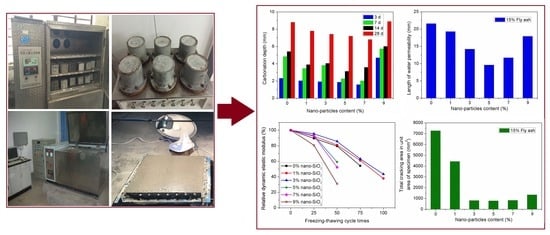Durability of Steel Fiber-Reinforced Concrete Containing SiO2 Nano-Particles
Abstract
:1. Introduction
2. Experimental Program
2.1. Materials
2.2. Mixing of Fresh Concrete
2.3. Carbonation Resistance Test
2.4. Permeability Resistance Test
2.5. Freeze-Thaw Resistance Test
2.6. Cracking Resistance Test
3. Results and Discussion
3.1. Carbonation Resistance
3.2. Permeability Resistance
3.3. Freeze-Thaw Resistance
3.4. Cracking Resistance
4. Conclusions
- Application of nano-SiO2 particles can significantly improve the permeability resistance, cracking resistance, freeze-thaw resistance, and carbonation resistance of concrete on condition that the SiO2 nano-particle dosage is within a certain limit. By increasing nano-SiO2 content, the permeability, cracking, freeze-thaw, and carbonation resistance of concrete were first enhanced, but then decreased. An excessive number of nano-SiO2 particles could adversely affect the durability of concrete.
- Incorporation of the correct amount of steel fibers improved the carbonation resistance of the concrete containing nano-SiO2; however, an excessive fraction of steel fiber would reduce the carbonization resistance of the specimens. In addition, the addition of steel fiber reduced the permeability resistance of the composite reinforced by nano-SiO2. Reinforcement of steel fibers enhanced the freezing-thawing and cracking resistance of concrete incorporating nano-SiO2. By increasing steel fiber volume content, the freeze-thaw resistance of concrete incorporating nano-particles exhibited an increasing trend, and the cracking resistance of the concrete decreased gradually.
Author Contributions
Funding
Conflicts of Interest
References
- Afroughsabet, V.; Biolzi, L.; Ozbakkaloglu, T. High-performance fiber-reinforced concrete: A review. J. Mater. Sci. 2016, 51, 6517–6551. [Google Scholar] [CrossRef]
- Zhang, P.; Li, Q. Effect of polypropylene fiber on durability of concrete composite containing fly ash and silica fume. Compos. Part B 2013, 45, 1587–1594. [Google Scholar] [CrossRef]
- Qureshi, L.A.; Ahmad, J.; Salahuddin, H. Seismic vulnerability assessment of strengthened glass fiber reinforced concrete (GFRC). KSCE J. Civ. Eng. 2017, 21, 2235–2244. [Google Scholar] [CrossRef]
- Wei, J.; Meyer, C. Improving degradation resistance of sisal fiber in concrete through fiber surface treatment. Appl. Surf. Sci. 2014, 289, 511–523. [Google Scholar] [CrossRef]
- Kizilkanat, A.B. Experimental evaluation of mechanical properties and fracture behavior of carbon fiber reinforced high strength concrete. Period. Polytech Civ. Eng. 2016, 60, 289–296. [Google Scholar] [CrossRef]
- Norhasri, M.S.M.; Hamidah, M.S.; Fadzil, A.M. Inclusion of nanometakaolin as additive in ultra high performance concrete (UHPC). Constr. Build. Mater. 2017, 127, 167–175. [Google Scholar] [CrossRef]
- Jalasutram, S.; Sahoo, D.R.; Matsagar, V. Experimental investigation of the mechanical properties of basalt fiber-reinforced concrete. Struct. Concr. 2017, 18, 292–302. [Google Scholar] [CrossRef]
- Zhang, P.; Zhao, Y.; Li, Q.; Zhang, T.; Wang, P. Mechanical properties of fly ash concrete composites reinforced with nano-SiO2 and steel fiber. Curr. Sci. 2014, 106, 1529–1537. [Google Scholar]
- Pajak, M.; Ponikiewski, T. Flexural behavior of self-compacting concrete reinforced with different types of steel fibers. Constr. Build. Mater. 2013, 47, 397–408. [Google Scholar] [CrossRef]
- Ma, H.L.; Cui, C.; Li, X.; Hu, S.L. Study on mechanical properties of steel fiber reinforced autoclaved lightweight shell-aggregate concrete. Mater. Design. 2013, 52, 565–571. [Google Scholar] [CrossRef]
- Mo, K.H.; Goh, S.H.; Alengaram, U.J.; Visintin, P.; Jumaat, M.Z. Mechanical, toughness, bond and durability-related properties of lightweight concrete reinforced with steel fibres. Mater. Struct. 2017, 50, 1–14. [Google Scholar] [CrossRef]
- Afroughsabet, V.; Biolzi, L.; Ozbakkaloglu, T. Influence of double hooked-end steel fibers and slag on mechanical and durability properties of high performance recycled aggregateconcrete. Compos. Struct. 2017, 181, 273–284. [Google Scholar] [CrossRef]
- Zhang, P.; Liu, C.H.; Li, Q.F.; Zhang, T.H.; Wang, P. Fracture properties of steel fibre reinforced high-performance concrete containing nano-SiO2 and fly ash. Curr. Sci. 2014, 106, 980–987. [Google Scholar]
- Zhang, P.; Wang, P.; Hou, D.; Liu, Z.; Haist, M.; Zhao, T. Application of neutron radiography in observing and quantifying the time-dependent moisture distributions in multi-cracked cement-based composites. Cem. Concr. Compos. 2017, 78, 13–20. [Google Scholar] [CrossRef]
- Zhang, P.; Wittmann, F.H.; Lura, P.; Müller, H.S.; Han, S.; Zhao, T. Application of neutron imaging to investigate fundamental aspects of durability of cement-based materials: A review. Cem. Concr. Res. 2018, 108, 152–166. [Google Scholar] [CrossRef]
- Zhang, P.; Dai, Y.; Ding, X.; Zhou, C.; Xue, X.; Zhao, T. Self-healing behaviour of multiple microcracks of strain hardening cementitious composites (SHCC). Constr. Build. Mater. 2018, 169, 705–715. [Google Scholar] [CrossRef]
- Zhang, P.; Zhao, Y.N.; Li, Q.F.; Wang, P.; Zhang, T.H. Flexural toughness of steel fiber reinforced high performance concrete containing nano-SiO2 and fly ash. Sci. World J. 2014, 2014, 1–11. [Google Scholar]
- Yu, R.; Spiesz, P.; Brouwers, H.J.H. Effect of nano-silica on the hydration and microstructure development of Ultra-High Performance Concrete (UHPC) with a low binder amount. Constr. Build. Mater. 2014, 65, 140–150. [Google Scholar] [CrossRef] [Green Version]
- Li, H.; Zhang, M.; Ou, J. Abrasion resistance of concrete containing nano-particles for pavement. Wear 2006, 260, 1262–1266. [Google Scholar] [CrossRef]
- Li, H.; Zhang, M.; Ou, J. Flexural fatigue performance of concrete containing nano-particles for pavement. Int. J. Fatigue 2007, 29, 1292–1301. [Google Scholar] [CrossRef]
- Zhang, M.; Li, H. Pore structure and chloride permeability of concrete containing nano-particles for pavement. Constr. Build. Mater. 2011, 25, 608–616. [Google Scholar] [CrossRef]
- Salemi, N.; Behfarnia, K. Effect of nano-particles on durability of fiber-reinforced concrete pavement. Constr. Build. Mater. 2013, 48, 934–941. [Google Scholar] [CrossRef]
- Ismael, R.; Silva, J.V.; Carmo, R.N.F.; Soldado, E.; Lourenco, C.; Costa, H.; Julio, E. Influence of nano-Al2O3 and nano-SiO2 addition on steel-to-concrete bonding. Constr. Build. Mater. 2016, 125, 1080–1092. [Google Scholar] [CrossRef]
- Wu, Z.; Shi, C.; Khayat, K.H. Multi-scale investigation of microstructure, fiber pullout behavior, and mechanical properties of ultra-high performance concrete with nano-CaCO3 particles. Cem. Concr. Compos. 2018, 86, 255–265. [Google Scholar] [CrossRef]
- Horszczaruk, E. Properties of cement-based composites modified with magnetite nanoparticles: A review. Materials 2019, 12, 326. [Google Scholar] [CrossRef]
- Arulraj, P.G.; Carmichael, J.M. Effect of nano-fly ash on strength of concrete. Int. J. Civ. Struct. Eng. 2011, 2, 475–482. [Google Scholar]
- Li, W.; Huang, Z.; Cao, F. Effects ofnano-silica andnano-limestone on flowability and mechanical properties of ultra-high-performanceconcretematrix. Constr. Build. Mater. 2015, 95, 366–374. [Google Scholar] [CrossRef]
- Li, H.; Xiao, H.G.; Guan, X.C.; Wang, Z.T.; Yu, L. Chloride diffusion in concrete containing nano-TiO2 under coupled effect of scouring. Compos. Part B 2015, 56, 698–704. [Google Scholar] [CrossRef]
- Braganca, M.O.G.P.; Portella, K.F.; Bonato, M.M. Performance of Portland cement concretes with 1%nano-Fe3O4 addition: Electrochemical stability under chloride and sulfate environments. Constr. Build. Mater. 2016, 117, 152–162. [Google Scholar] [CrossRef]
- Li, W.; Zhu, F.S.; Wang, X.C.; Zhao, Y.M. Mechanical properties and durability of concrete doped with nano-CaCO3. J. Nanoelectron. Optoelectron. 2016, 12, 808–814. [Google Scholar] [CrossRef]
- Zhang, P.; Zhao, Y.N.; Liu, C.H.; Wang, P.; Zhang, T.H. Combined effect of nano-SiO2 particles and steel fibers on flexural properties of concrete composite containing fly ash. Sci. Eng. Compos. Mater. 2014, 21, 597–605. [Google Scholar] [CrossRef]
- Jo, B.W.; Kim, C.H.; Lim, J.H. Investigations on the development of powder concrete with nano-SiO2 particles. KSCE J. Civ. Eng. 2007, 11, 37–42. [Google Scholar] [CrossRef]
- Gao, D.; Wang, Z.; Qian, W.; Zhao, G. Fracture energy and crack opening displacement of steel fiber reinforced high strength concrete. J. Chin. Ceram. Soc. 2006, 34, 192–198. [Google Scholar]
- Standard Test Methods for Fiber Reinforced Concrete; CECS 13-2009; Planning Press of China: Beijing, China, 2010.
- Test Methods of Cement and Concrete for Highway Engineering; JTJ E30-2005; China Communications Press: Beijing, China, 2005.
- Standard for Test Methods of Long-Term Performance and Durability of Ordinary Concrete; GB/T 50082-2009; Building Industry Press: Beijing, China, 2010.
- Phung, Q.T.; Maes, N.; Jacques, D.; Bruneel, E.; Driessche, I.V.; Ye, G.; Schutter, G.D. Effect of limestone fillers on microstructure and permeability due to carbonation of cement pastes under controlled CO2 pressure conditions. Constr. Build. Mater. 2015, 82, 376–390. [Google Scholar] [CrossRef]
- Yang, J.; Yang, R.; Yang, X. Study on carbonation performance of air-entrained silica fume concrete. Ningxia Eng. Technol. 2017, 16, 248–252. [Google Scholar]
- Kulakowski, M.P.; Pereira, F.M.; Molin, D.C.C.D. Carbonation-induced reinforcement corrosion in silica fume concrete. Constr. Build. Mater. 2009, 23, 1189–1195. [Google Scholar] [CrossRef]
- Guo, Y.; Pan, H.; Li, Z. Study on carbonation of steel-fiber reinforced concrete. Concrete 2007, 29, 45–47. [Google Scholar]
- Zhang, C.S.; Meng, L.Q.; Ji, A.Y.; Liang, J.L.; Li, L.L. Mechanism study of steel fiber content on the carbonization resistance of high performance concrete. Bull. Chin. Ceram. Soc. 2018, 37, 3206–3212. [Google Scholar]
- Phung, Q.T.; Maes, N.; Schutter, G.D.; Jacques, D.; Ye, G. Determination of water permeability of cementitious materials using a controlled constant flow method. Constr. Build. Mater. 2013, 47, 1488–1496. [Google Scholar] [CrossRef]
- Qin, Y.; Zhang, M.; Mei, G. A new simplified method for measuring the permeability characteristics of highly porous media. J. Hydrol. 2018, 562, 725–732. [Google Scholar] [CrossRef]
- Liu, R.; Xiao, H.G.; Liu, J.L.; Guo, S.; Pei, Y.F. Improving the microstructure of ITZand reducing the permeability of concrete with various water/cement ratios using nano-silica. J. Mater. Sci. 2019, 54, 444–456. [Google Scholar] [CrossRef]
- Ardalan, R.B.; Jamshidi, N.; Arabameri, H.; Joshaghani, A.; Mehrinejad, M.; Sharafi, P. Enhancing the permeability and abrasion resistance of concrete using colloidalnano-SiO2 oxide and spraying nanosilicon practices. Constr. Build. Mater. 2017, 146, 128–135. [Google Scholar] [CrossRef]
- Puentes, J.; Barluenga, G.; Palomar, I. Effect of silica-based nano and micro additions on SCC at early age and on hardened porosity and permeability. Constr. Build. Mater. 2015, 81, 154–161. [Google Scholar] [CrossRef]
- Huang, G.; Xie, X. Experimental study on the effect of nano-SiO2 to durability in hydraulic concrete. Yellow River. 2011, 33, 138–140. [Google Scholar]
- Hubert, M.; Desmettre, C.; Charron, J.P. Influence offibercontent and reinforcement ratio on the waterpermeabilityof reinforcedconcrete. Mater. Struct. 2015, 48, 2795–2807. [Google Scholar] [CrossRef]
- Fatemeh, S.; Kiachehr, B. The effects of nano particles on freeze and thaw resistance of alkali-activated slag concrete. Constr. Build. Mater. 2018, 176, 172–178. [Google Scholar]
- Zhang, M.; Li, X. Sulfate corrosion resistance of foundation concrete with nano-particles under freeze-thaw cycles. J. Nat. Disast. 2018, 27, 94–99. [Google Scholar]
- Li, G.; Gao, B. Effect of level SiO2 and level CaCO3 on concrete performance. J. China Rail. Soc. 2006, 28, 131–136. [Google Scholar]
- Sun, H.Y.; He, Z. Effect on the anti-cracking performance of hybrid concrete with propylene and steel fiber. Fly Ash Compr. Util. 2008, 22, 19–22. [Google Scholar]
- Shen, D.; Liu, X.; Li, Q.; Sun, L.; Wang, W. Early-age behavior and cracking resistance of high-strength concrete reinforced with Dramix 3D steel fiber. Constr. Build. Mater. 2019, 196, 307–316. [Google Scholar] [CrossRef]
- Yoo, D.Y.; Lee, J.Y.; Shin, H.O.; Yoon, Y.S. Enhancing cracking resistance of ultra-high-performance concrete slabs using steel fibres. Mag. Concr. Res. 2015, 67, 487–495. [Google Scholar] [CrossRef]

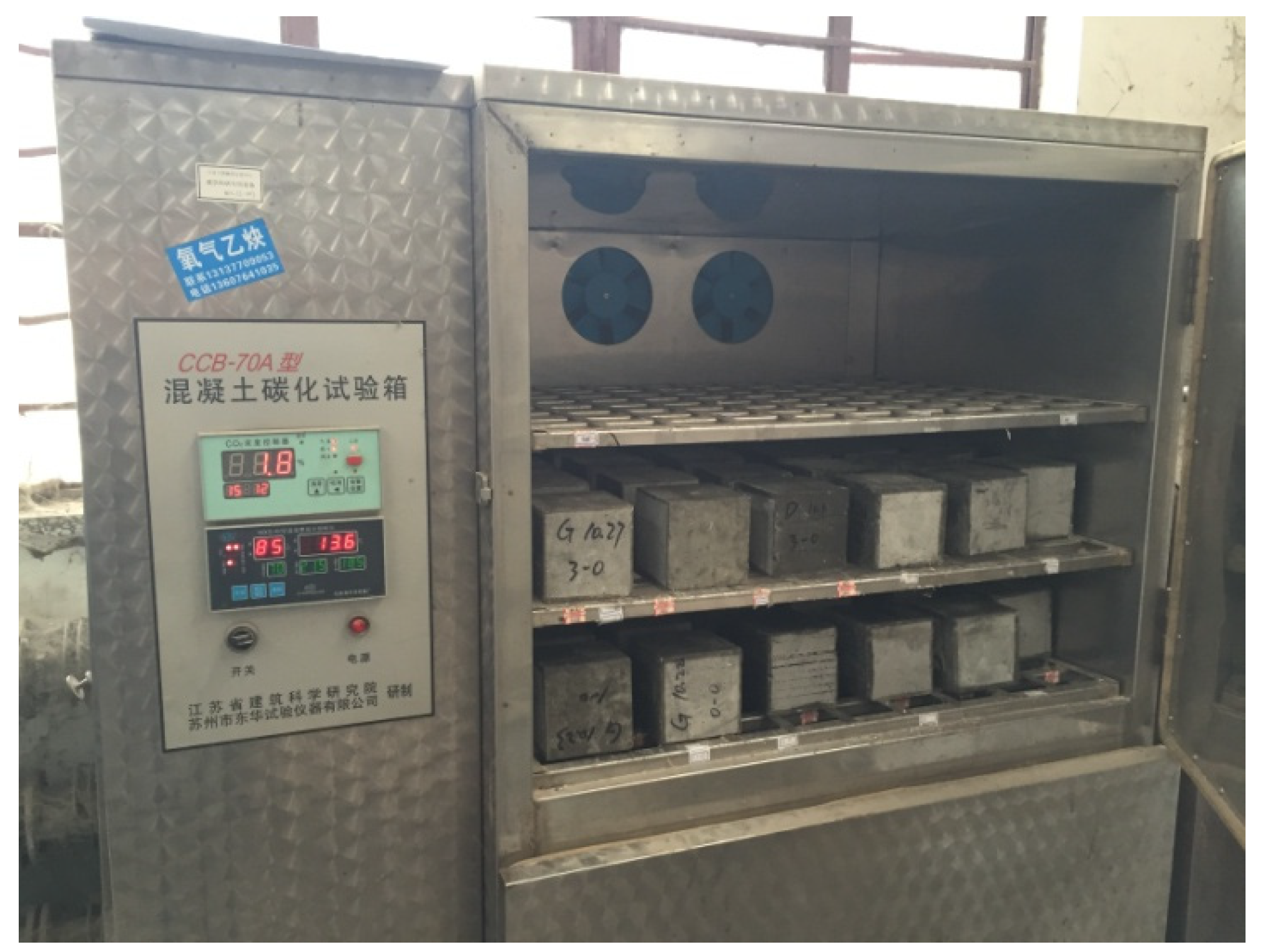
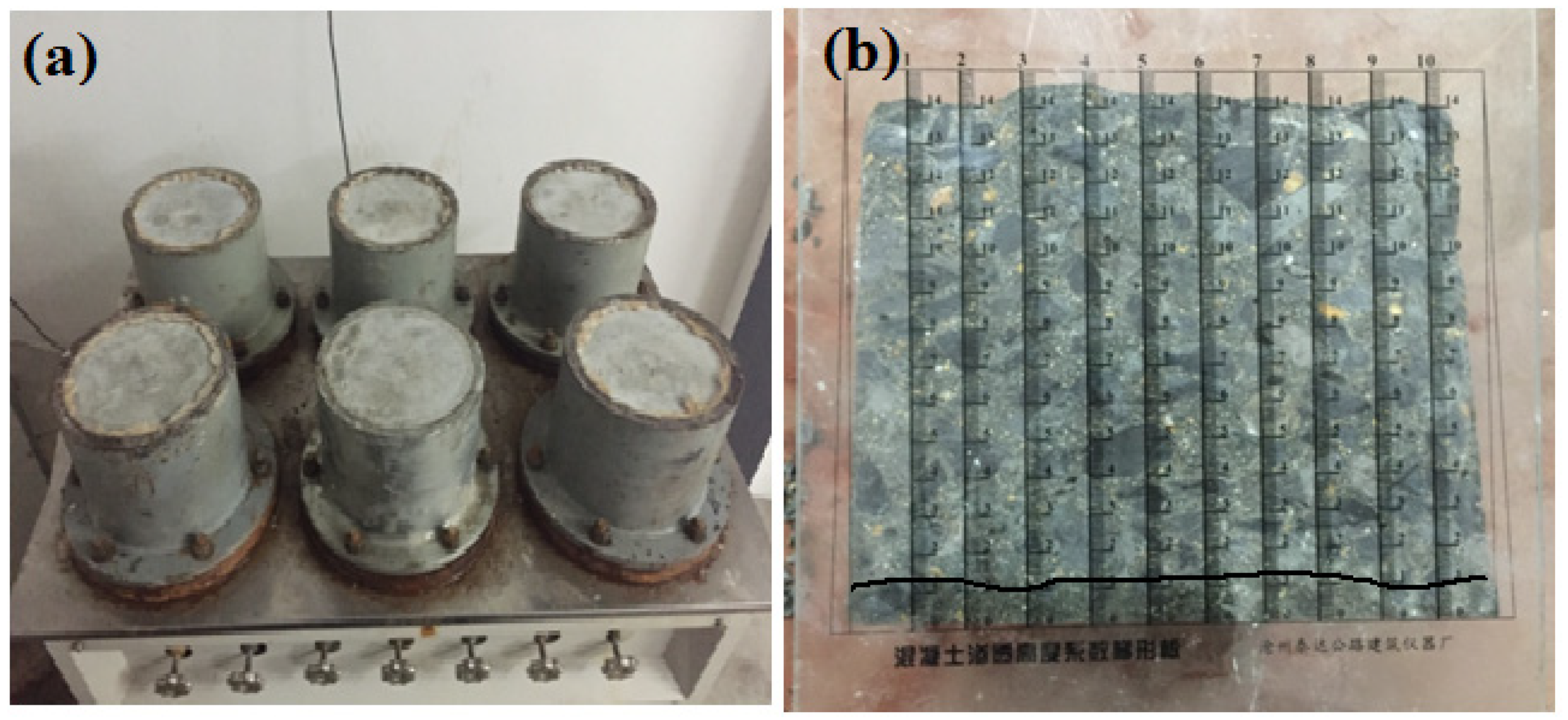
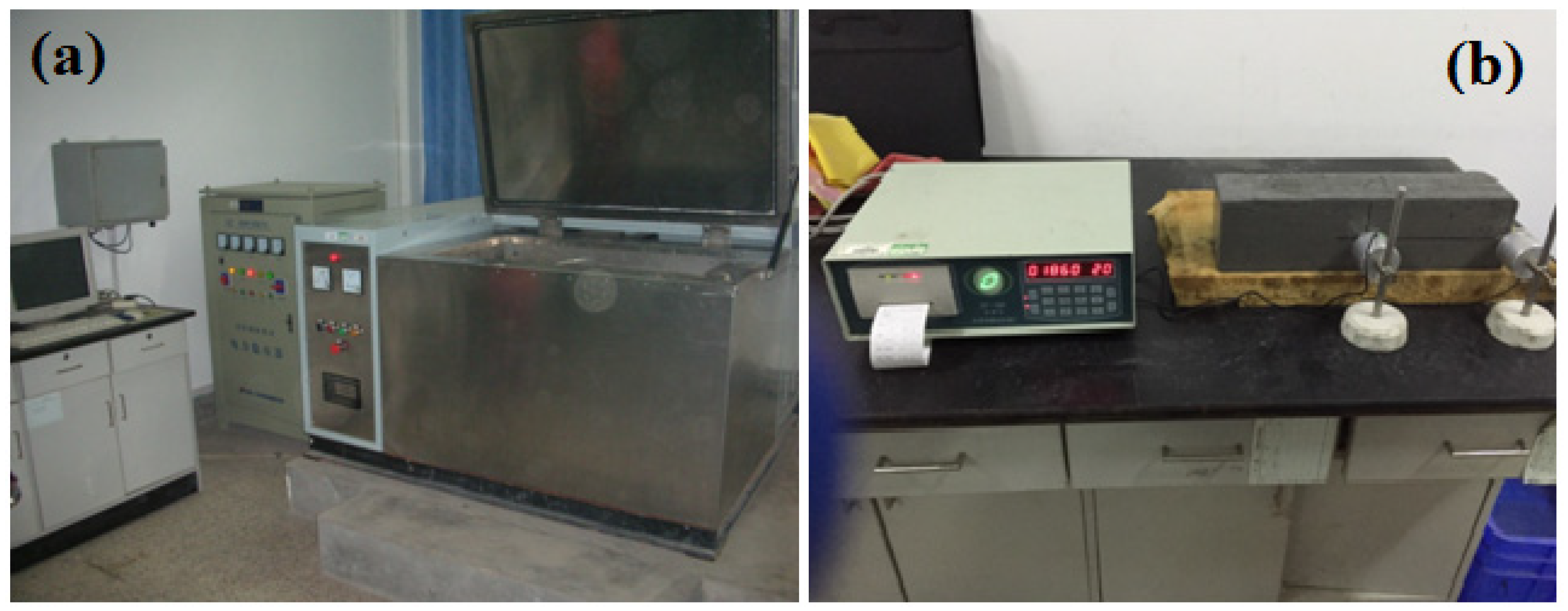
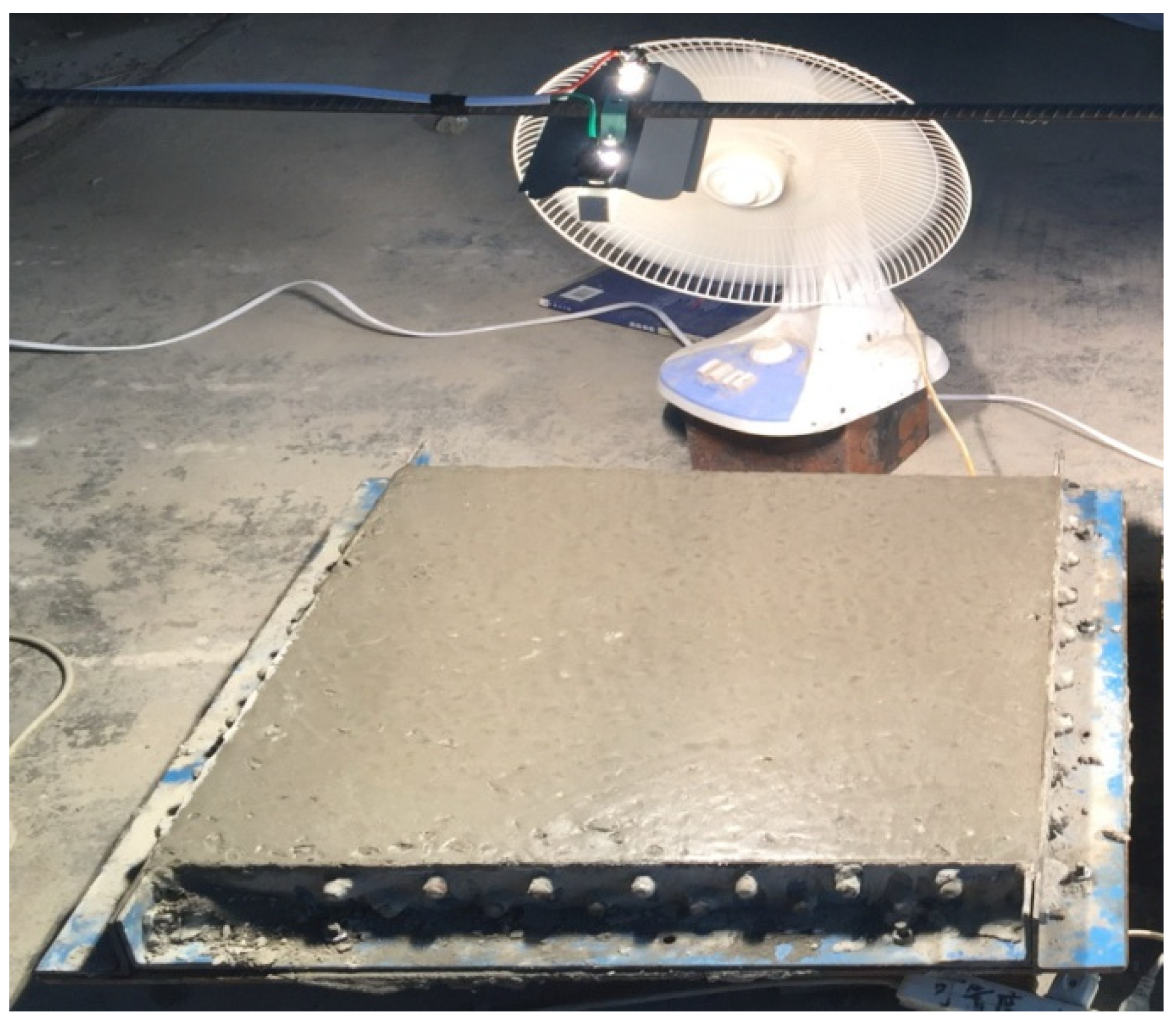
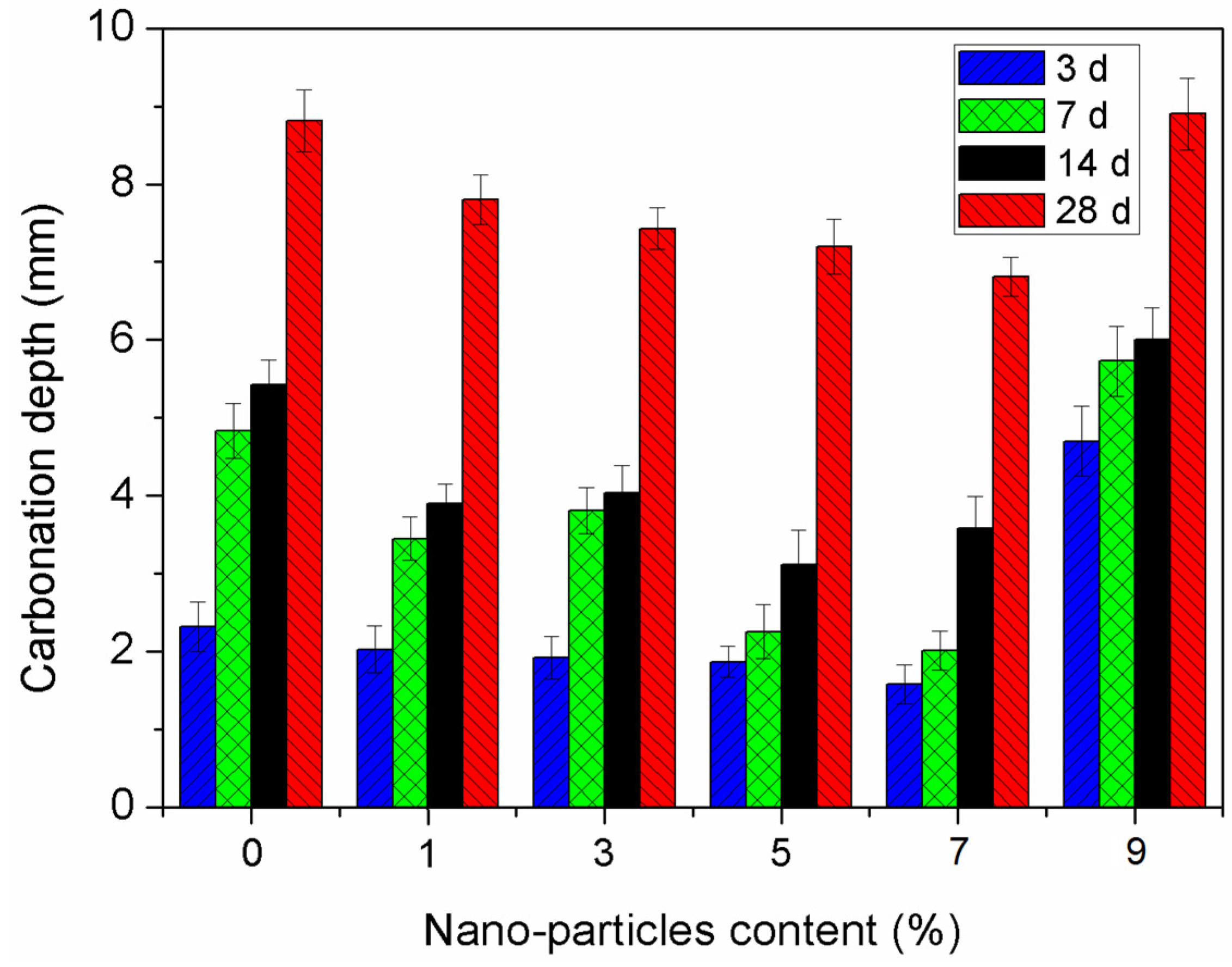
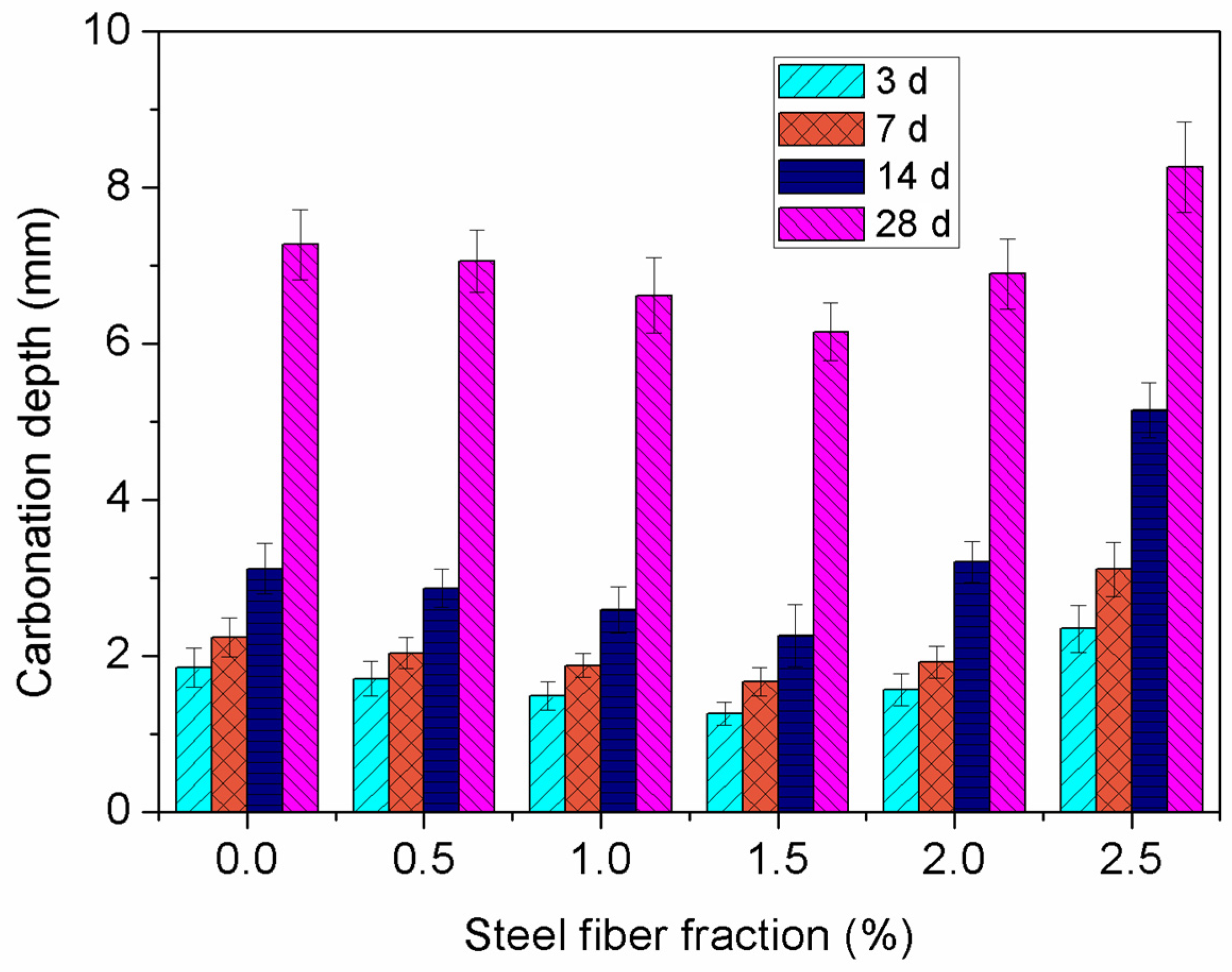
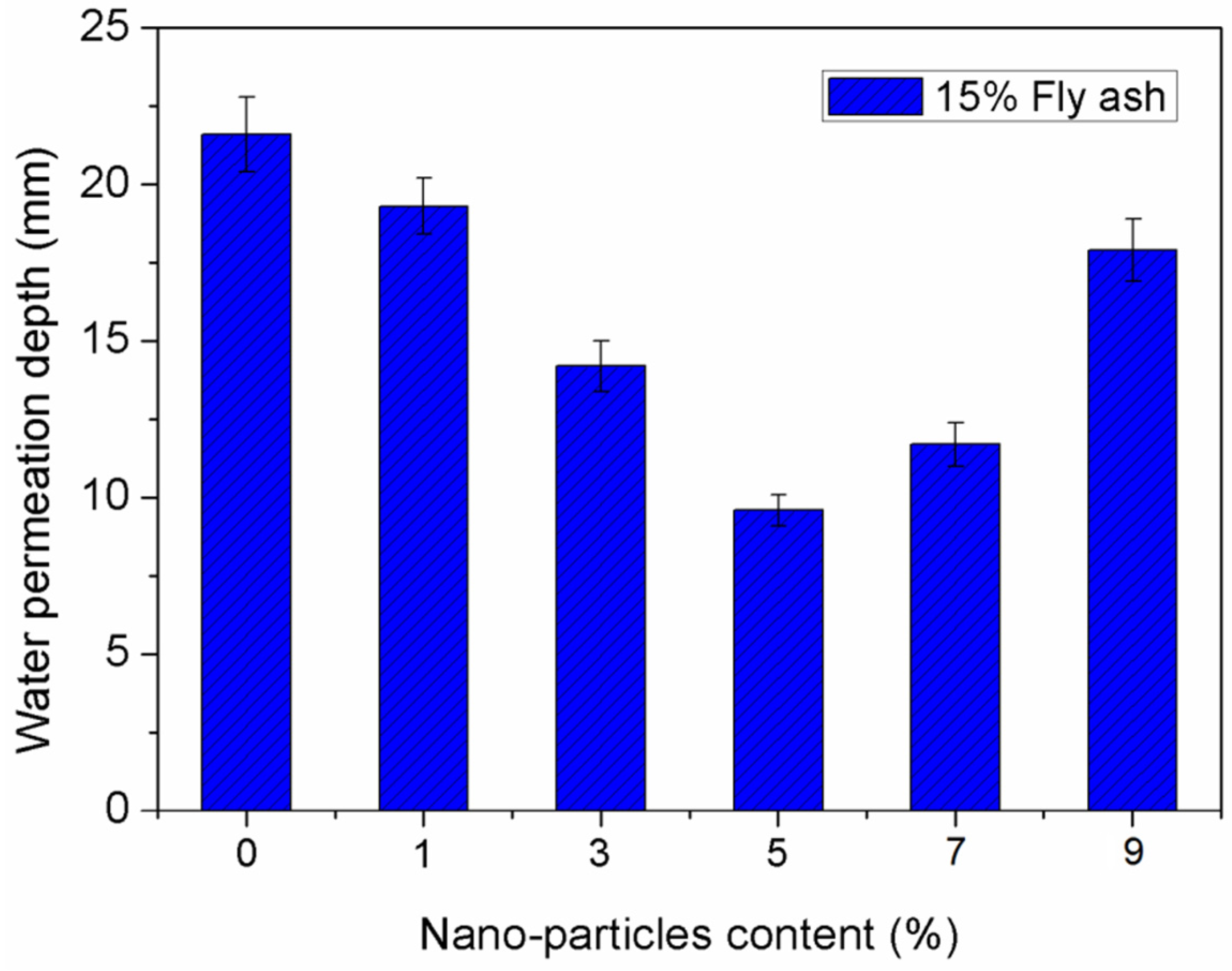

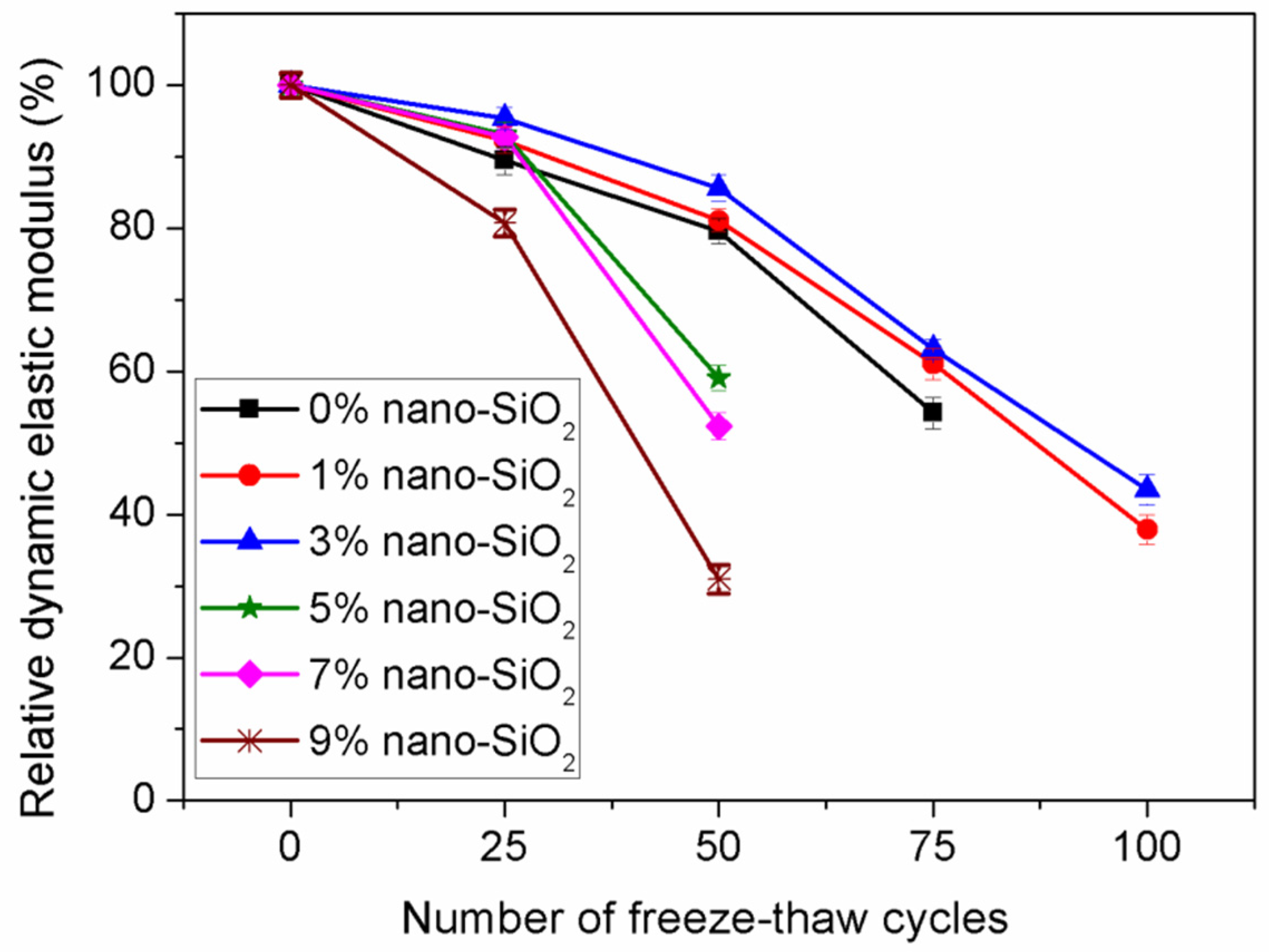
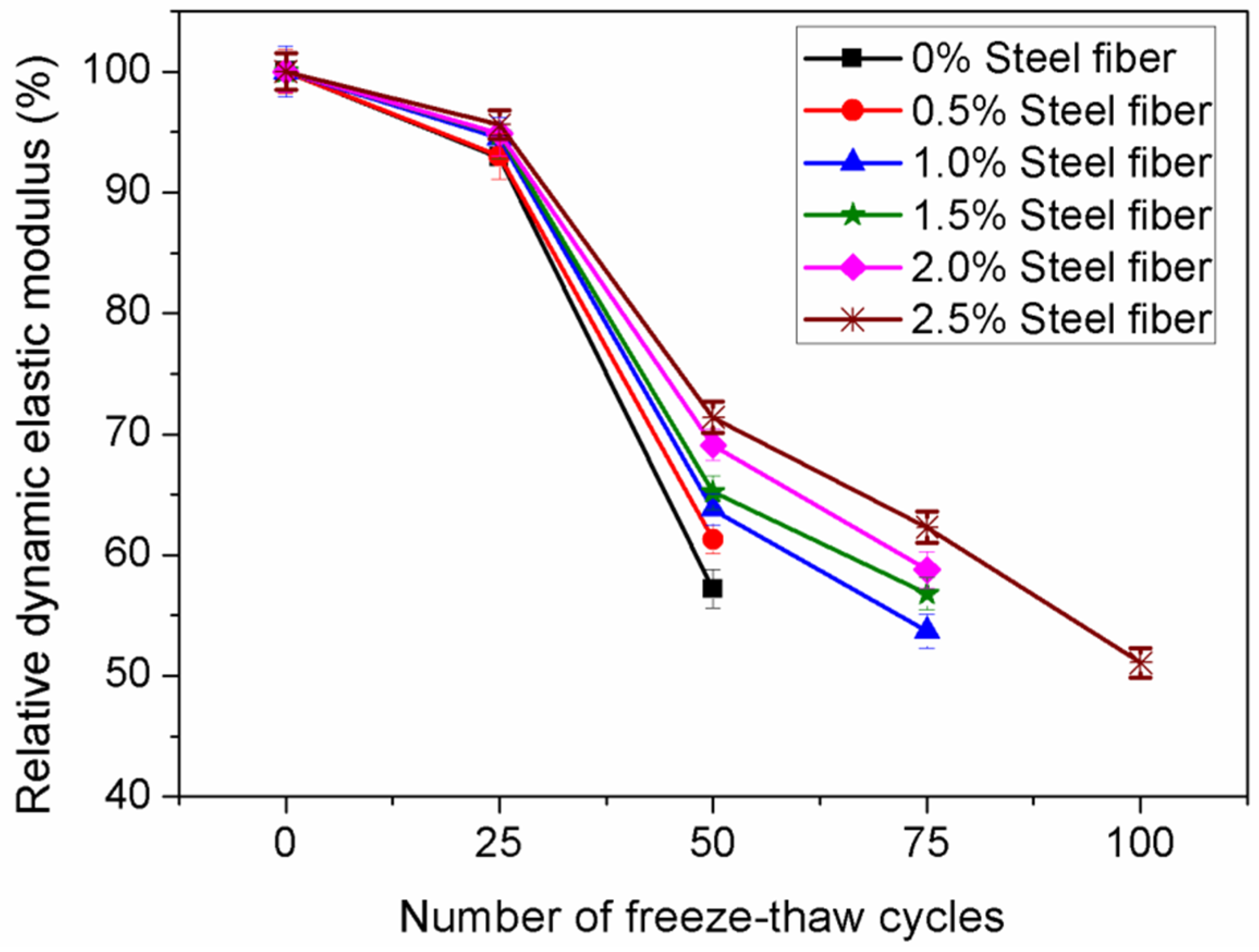

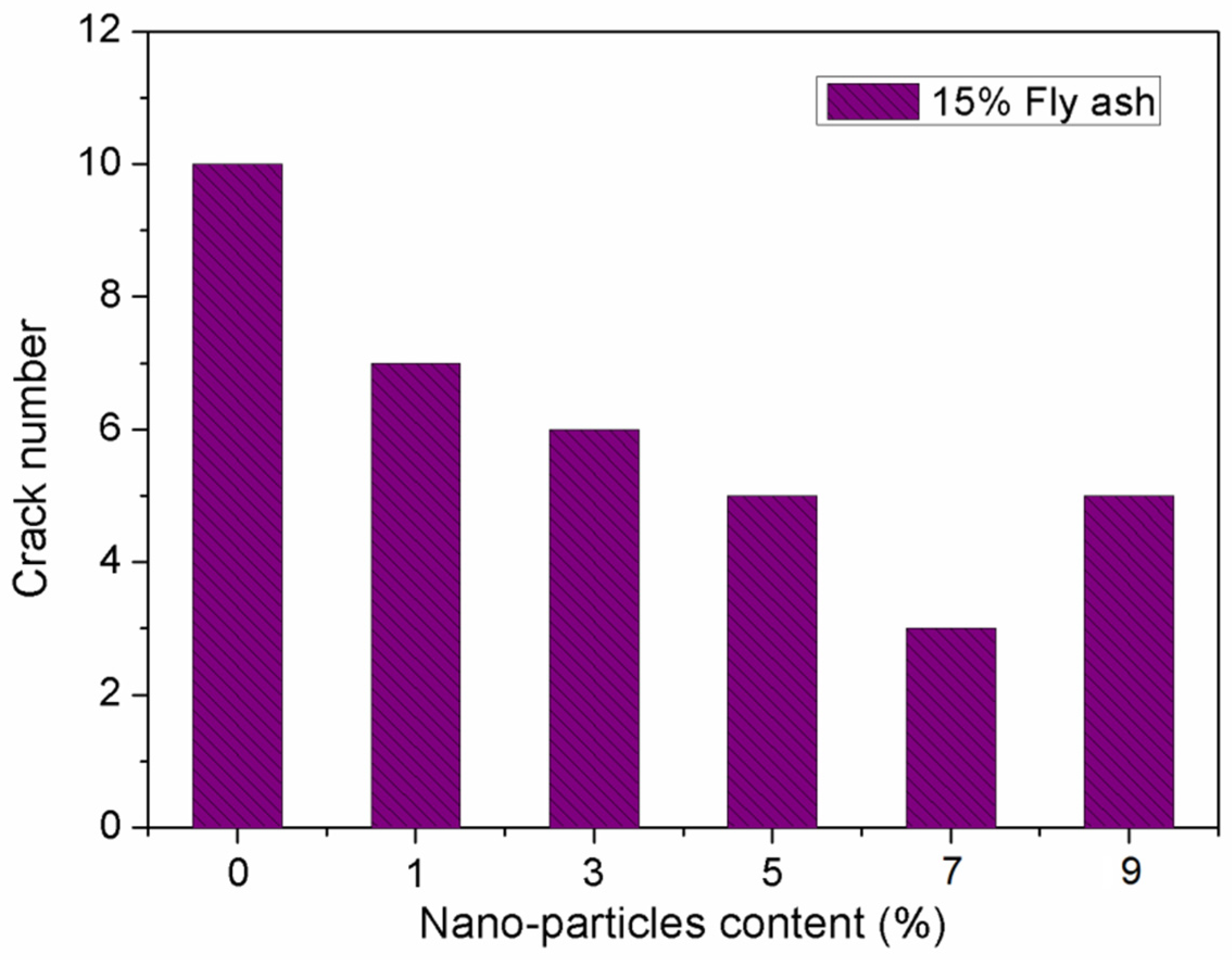
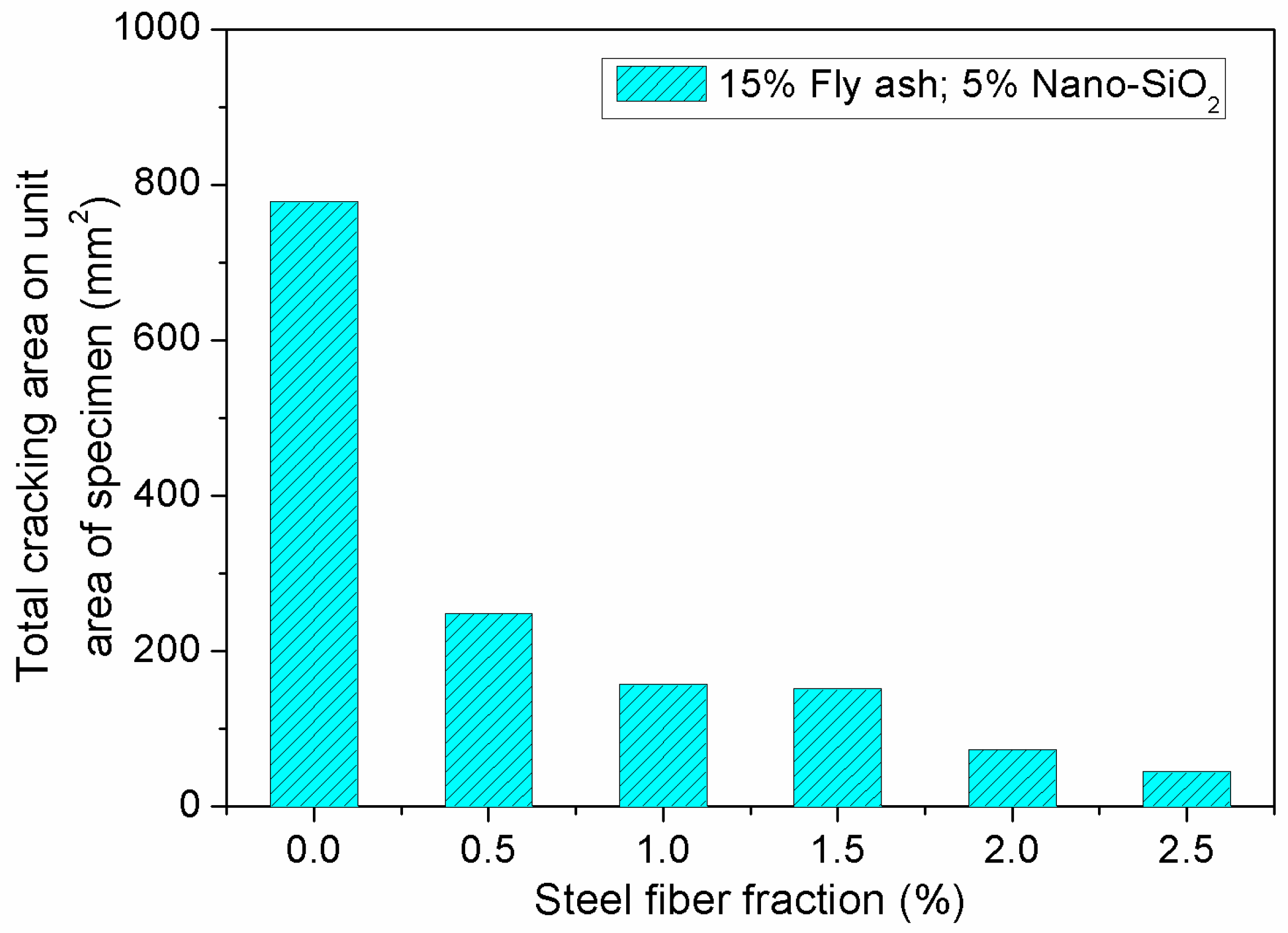
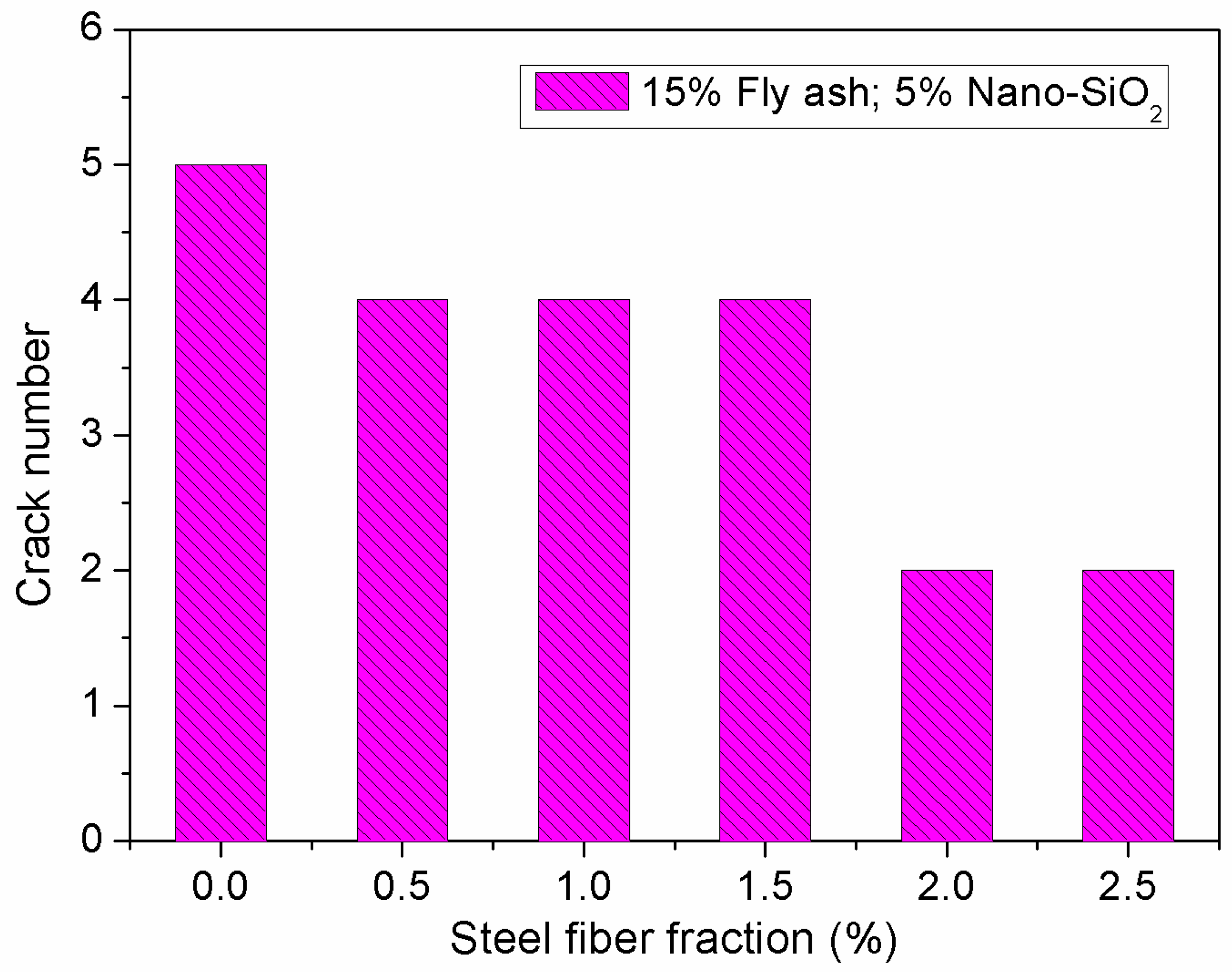
| Cement | Specific Gravity | Setting Time (min) | Compressive Strength (MPa) | Flexure Strength (MPa) | ||||
| Initial Setting | Final Setting | 3d | 28d | 3d | 28d | |||
| 3.16 | 90 | 286 | 26.1 | 53.8 | 5.37 | 8.52 | ||
| Fly Ash | Moisture Content (%) | Ignition Loss (%) | SO3 (%) | Density (s) | Fineness (s) | Water Demand (%) | ||
| 0.5 | 5.24 | 1.22 | 2.252 | 9.22 | 91 | |||
| Steel Fiber | Tensile Strength (MPa) | Length (mm) | Diameter (mm) | Length to Diameter Ratio | ||||
| 800 | 32 | 2.4 | 40 | |||||
| Average Particle Size (nm) | SiO2 Content (%) | Specific Surface Area (m2/g) | Bulk Density (g/cm3) | PH Value |
|---|---|---|---|---|
| 30 | 99.5 | 200 | 0.055 | 6 |
| Cement (kg/m3) | Fly Ash (kg/m3) | Nano SiO2 (%) | Steel Fiber (%) | Fine Aggregate (kg/m3) | Coarse Aggregate (kg/m3) | Water (kg/m3) | Water Reducing Admixture (kg/m3) |
|---|---|---|---|---|---|---|---|
| 461.89 | 81.51 | 0 | 0 | 647 | 1151 | 158 | 5.98 |
| 456.46 | 81.51 | 1 | 0 | 647 | 1151 | 158 | 5.98 |
| 445.59 | 81.51 | 3 | 0 | 647 | 1151 | 158 | 5.98 |
| 434.72 | 81.51 | 5 | 0 | 647 | 1151 | 158 | 5.98 |
| 423.85 | 81.51 | 7 | 0 | 647 | 1151 | 158 | 5.98 |
| 412.98 | 81.51 | 9 | 0 | 647 | 1151 | 158 | 5.98 |
| 434.72 | 81.51 | 5 | 0.5 | 647 | 1151 | 158 | 5.98 |
| 434.72 | 81.51 | 5 | 1.0 | 647 | 1151 | 158 | 5.98 |
| 434.72 | 81.51 | 5 | 1.5 | 647 | 1151 | 158 | 5.98 |
| 434.72 | 81.51 | 5 | 2.0 | 647 | 1151 | 158 | 5.98 |
| 434.72 | 81.51 | 5 | 2.5 | 647 | 1151 | 158 | 5.98 |
© 2019 by the authors. Licensee MDPI, Basel, Switzerland. This article is an open access article distributed under the terms and conditions of the Creative Commons Attribution (CC BY) license (http://creativecommons.org/licenses/by/4.0/).
Share and Cite
Zhang, P.; Li, Q.; Chen, Y.; Shi, Y.; Ling, Y.-F. Durability of Steel Fiber-Reinforced Concrete Containing SiO2 Nano-Particles. Materials 2019, 12, 2184. https://doi.org/10.3390/ma12132184
Zhang P, Li Q, Chen Y, Shi Y, Ling Y-F. Durability of Steel Fiber-Reinforced Concrete Containing SiO2 Nano-Particles. Materials. 2019; 12(13):2184. https://doi.org/10.3390/ma12132184
Chicago/Turabian StyleZhang, Peng, Qingfu Li, Yuanzhao Chen, Yan Shi, and Yi-Feng Ling. 2019. "Durability of Steel Fiber-Reinforced Concrete Containing SiO2 Nano-Particles" Materials 12, no. 13: 2184. https://doi.org/10.3390/ma12132184
APA StyleZhang, P., Li, Q., Chen, Y., Shi, Y., & Ling, Y.-F. (2019). Durability of Steel Fiber-Reinforced Concrete Containing SiO2 Nano-Particles. Materials, 12(13), 2184. https://doi.org/10.3390/ma12132184




